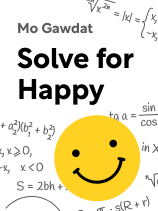

This article is an excerpt from the Shortform book guide to "Solve for Happy" by Mo Gawdat. Shortform has the world's best summaries and analyses of books you should be reading.
Like this article? Sign up for a free trial here.
When it comes to your own life, what can you control? Is your perception accurate?
Citing black swan events and the butterfly effect, Mo Gawdat argues that the notion that you’re in control of your life is just a myth. He advises that, in order to find happiness, you should come to grips with that reality and employ something he calls “committed acceptance.”
Keep reading to get a better understanding of what you control in your life and how to practice committed acceptance.
What Can You Control?
What can you control in your life? If you’re like most people, you probably think that you’re in control of what you eat for breakfast, what career you choose, and so on. However, Gawdat argues that you actually control relatively little.
In support of his claim, Gawdat appeals to Nassim Nicholas Taleb’s view, outlined in The Black Swan, that seemingly improbable events happen frequently. Taleb argues that these “black swan” events, like stock market crashes and natural disasters, happen often on a global scale. However, because we think they’re uncommon, we’re unprepared and forced to abdicate control when they happen. For instance, Hurricane Katrina displaced over a million people in 2005, many of whom likely thought they could decide which city they live in.
(Shortform note: Taleb further argues that so-called “experts” are most guilty of failing to predict black swans. Because they won’t admit they were wrong, however, they typically make three excuses for these missed predictions: that they lacked access to the right information, that they nearly predicted the black swan correctly, or that the black swan was a statistical anomaly.)
Gawdat also appeals to the “butterfly effect,” Edward Lorenz’s theory that a butterfly flapping its wings in Brazil could cause a tornado in Texas. More generally, the theory suggests that imperceptible shifts in a system can yield widespread consequences. Because we can’t control these shifts, our sense of control over the entire system is misguided.
(Shortform note: Although physicists accept the butterfly effect in normal circumstances, which are largely governed by the laws of classical physics, simulations suggest the butterfly effect is negated at the quantum level, which is where minuscule atomic and subatomic particles interact.)
Because you mistakenly feel in control, your expectations are overinflated, preventing you from solving the happiness formula.
Committed Acceptance
Nonetheless, Gawdat doesn’t recommend that you completely jettison control. Rather, he counsels what he calls “committed acceptance”: Do your best, but be detached from the consequences. For example, you might fill out a job application to the best of your abilities but remain detached about whether you’ll get the job.
(Shortform note: Committed acceptance is grounded in the Buddhist notion of detachment, which has wide-reaching implications. In addition to not worrying about our actions’ consequences, detachment requires us to abandon our attachment to worldly goods more generally. So, it might require us to give up our over-reliance on our money, our cars, our house, and so on. Because these objects are transient, abandoning our attachment to them prevents us from having only transient happiness.)
By taking this approach, you remain concerned with factors in your control while relinquishing worries over factors outside your control. In so doing, you avoid the suffering which follows from a false sense of control.
(Shortform note: In The Happiness Trap, Russ Harris similarly argues that committed action is pivotal for happiness, where we take actions toward our goals while accepting that we can’t control the outcomes. Specifically, he claims that committed action requires fortitude—accepting unwanted side effects of committed action—and commitment—persevering despite inevitable failure.)

———End of Preview———
Like what you just read? Read the rest of the world's best book summary and analysis of Mo Gawdat's "Solve for Happy" at Shortform.
Here's what you'll find in our full Solve for Happy summary:
- The six misconceptions that cause us to suffer
- How to remove the seven weaknesses that hinder your happiness
- The five pillars to becoming permanently happy






